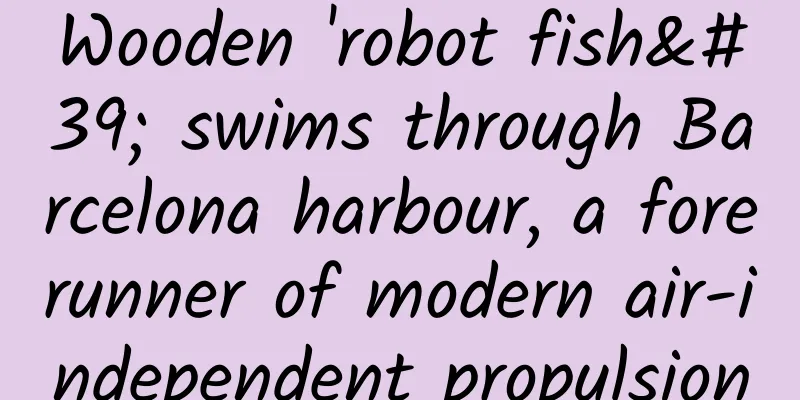Wooden 'robot fish' swims through Barcelona harbour, a forerunner of modern air-independent propulsion

|
More than 170 years ago in Spain, a young man began to raise funds to build a "robot fish" that could dive. He hoped that fishermen could take this wooden submersible to safely complete the work of collecting corals. However, like many failed inventions in history, he always worked under a shortage of funds and ultimately failed. But his second-generation "robot fish" was able to temporarily break free from the "constraints" of human power and became the starting point for the air-independent propulsion system (AIP) used on modern submarines. Written by | Ma Zhiheng In the courtyard of the Barcelona Maritime Museum (Museu Marítim Barcelona), there is a wooden device that looks like both a barracuda and a submarine. If you don't read the sign, you might mistake it for a sculpture that represents maritime culture, or a closed museum store. However, more than 160 years ago, there really was a submarine that looked like this, and it swam in the waters of Barcelona Harbor. Moreover, it has a "successor" that looks like a barracuda. If you can’t publish, build submarines The builder of these two submarines was Narcís Monturiol i Estarriol, the son of a cooper in Figueres, Catalonia. Although he majored in law in college, he never worked in the legal field after getting his degree. Instead, he wanted to be a publisher. In 1846, at the age of 27, he opened a publishing company in Barcelona, specializing in producing newspapers, magazines and pamphlets promoting feminism and utopian socialism. These very avant-garde ideas at the time also attracted some loyal readers. However, the good times did not last long. In 1848, revolutions against monarchy broke out in many parts of Europe. The Spanish government believed that Montulio's remarks affected social stability, so it ordered the suspension of a magazine he produced that promoted utopian socialism. He had no choice but to leave Barcelona and flee to France. The following year, he returned to Barcelona, only to find that the government had issued a series of bans on the publishing industry. It was really uncomfortable to dance with shackles, and in his opinion, there was no future in publishing. When the atmosphere in Barcelona became more depressing, he decided to go to the coastal town of Cadaqués to take shelter. In order to make a living, Montulio began to sell landscape paintings on the beach, which often allowed him to meet poor fishermen who were diving to collect corals. These people did not have any diving equipment, but just took a deep breath and went into the sea, using the simple tools in their hands to dig out the corals and sell them on the shore. Although the carved and modified corals will eventually become expensive luxury goods, these fishermen at the end of the industrial chain can only get a small amount of money that is barely enough to live on, and they have to risk their lives for this job. Not long after Montulio arrived in Cadaques, he saw with his own eyes a fisherman who unfortunately drowned because he held his breath for too long. The miserable lives of these fishermen made Montulio deeply aware that the world was full of all kinds of exploitation and injustice, and he should do something to protect the weak. After much thought, he found a solution: since the printing press and movable lead type could quickly print out thousands of newspapers and books, eliminating the hard work of copyists, then he might be able to build a machine that people can sit on to safely dive underwater and dig for all kinds of treasures in the sea for rewards. In his view, underwater navigation can even be regarded as a symbol of equality: while the oceans around the world are being divided, the world under the water is an unrestrained new world where people can sail freely. This is just like the popularization of printing presses and movable lead type, which greatly reduced the price of books and gave ordinary people the freedom to read. But Monturio also knew that his idea was too advanced for the Spanish society at that time, and he would become a laughing stock if he spoke it out. It was not until 1857 that he finally decided to put his idea into practice with the encouragement of his friends. In September of that year, he managed to raise 10,000 pesetas (the Spanish currency at that time), which was equivalent to 3.2 kilograms of gold, and registered the first Spanish commercial society for underwater navigation in Barcelona. The following year, Montulio published a paper titled "The Fish-shaped Boat" (El Ictíneo o barco-pez) to introduce his concept to people. According to his explanation, the body of a fish is most suitable for moving in water, and this "submersible boat", that is, a submarine, is a full-scale imitation of fish. Fish swim by swinging their tail fins, and other fins are used to keep their bodies stable in the water or turn; the swim bladder is responsible for adjusting the depth of the fish in the water. The "underwater boat" he wanted to build was propelled by a propeller at the tail and the rudder at the tail was used to adjust the course; the skids at the bottom of the boat were like the dorsal fin of a fish, but moved to the abdomen to keep the hull stable; the ballast water tank in the boat was like the swim bladder, and the diving depth was adjusted by filling and draining water. Therefore, he combined the Greek words "ikhtys" (fish) and "naus" (ship) and used "fish-shaped boat" (ictíneo) to describe the submarine he invented. Narcisse Montulio in his later years Learn from fish and explore the underwater world When the paper was published, the construction of the "fish-shaped boat" had already begun. But in Spain at that time, the knowledge of ship design was still part of naval engineering, and almost only military engineers could master it; and Monturio had no professional training in this area, only experience in carpentry as a teenager. Therefore, the work of perfecting the design and construction of the "fish-shaped boat" was completed by Monturio and the team of shipbuilding engineers he hired. This way of working made the "fish-shaped boat" an important milestone in the Spanish Industrial Revolution - because this may be the first time in Spanish history that craftsmen who work based on experience and "professionally trained" engineers have worked together on an engineering project. Montulio hopes that the "fish-shaped boat" can eventually dive to a depth of 500 meters, which is comparable to modern military submarines. At that depth, the water pressure is equivalent to 50 atmospheres, and the most pressure-resistant shape is a sphere. He wants to build a pressure-resistant cabin with steel, installed in the fish-shaped wooden shell, as a shelter for the crew. But because of very limited funds, he can only settle for the second best and change the pressure-resistant cabin to wood. As the son of a cooper, Montulio made a pressure-resistant cabin with olive wood by slightly modifying the wooden barrel. It is an olive-shaped ellipsoid with a long diameter of 4 meters and a short diameter of 2 meters. It is covered with a 2 mm thick copper sheet for reinforcement and has a reinforcing hoop made of oak. The interior space of this cabin is about 7 cubic meters, which can accommodate 4 people; outside is a fish-shaped hull that is 7 meters long, 3.5 meters high and 2.5 meters wide. On the side of the hull, where the pressure-resistant cabin is closest to the outer shell, there is a pair of main observation windows, and other observation windows are located on the top and bow. The glass of these observation windows is carefully made into a frustum, that is, a pudding-like shape, with a larger diameter on the side close to the water. In this way, when the "fish-shaped boat" dives underwater, the water pressure will press the observation window firmly against the hull, thereby ensuring the safety of the crew. In the cavity between the pressure cabin and the fish-shaped hull, there are four ballast water tanks, which Montulio calls "swim bladders", which allow the "fish-shaped boat" to float and dive freely in the water. If the boat accidentally dives too fast and loses balance, the crew can move a huge weight in the fish-shaped hull back and forth to make adjustments. To this day, deep-sea submersibles used for underwater scientific expeditions still adopt this layout, using pressure-resistant cabins equipped with observation windows to protect divers and passengers, and allowing them to directly view the seabed scenes through the observation windows; they will also arrange ballast water tanks between the pressure cabins and the outer shell, as well as various equipment that is not easily affected by water pressure. After diving underwater, ensuring the survival of the crew became the top priority. After calculations, Montulio found that the oxygen in the pressure chamber could provide breathing for the four crew members for about two hours, but in the last period of time, the concentration of carbon dioxide in the pressure chamber would increase significantly, causing the crew members to lose strength due to lack of oxygen. Therefore, he installed a ventilation device filled with calcium hydroxide in the pressure chamber, allowing the air in the chamber to flow through it continuously. In this process, carbon dioxide reacts with calcium hydroxide to become water and calcium carbonate, allowing the crew members to breathe "fresh" air and extend their stay underwater by about twice. But Montulio was not satisfied with this; he even wanted to use potassium permanganate and concentrated sulfuric acid to react chemically to produce oxygen directly underwater. However, this reaction would release a lot of heat, and it was too dangerous to store a large amount of concentrated sulfuric acid underwater, so he gave up this plan at the last moment and placed a special small candle in the pressure chamber as a light source. Although the burning of the candle would consume some oxygen, if the oxygen in the pressure chamber was about to run out, the candle flame would turn bright red, and the crew would immediately let the "fish-shaped boat" surface. A replica of the first "fish-shaped boat" collected by the Barcelona Maritime Museum | Source: Ma Zhiheng/Photography The first sea trial was not successful On June 28, 1859, Montulio's "fish-shaped boat" began its first trial voyage in the port of Barcelona. To be on the safe side, he decided to dive only to a depth of 50 meters for the first time, but this was already beyond the maximum depth that a diver without equipment could reach. But even with such caution, an accident still occurred during the sea trial. On the seabed of that area, there happened to be some wooden piles left by the previously demolished port buildings, but they were not visible from the shore because of the seawater. When the "fish-shaped boat" dived into the seabed, it hit the "undersea forest" composed of wooden piles, and lost a ballast tank on the spot. The fish-shaped shell also had several holes. The collision also cracked part of the glass of the observation window. Fortunately, the unique structure of the observation window allowed the water pressure to become the force to protect the glass, and Montulio in the pressure-resistant cabin escaped. However, at this time, he did not feel lucky for escaping death. Building the "fish-shaped boat" had already spent all the funds he raised. If he spent more money to completely repair the damage caused by the accident, he would be really penniless. But diving with injuries was too dangerous, so he decided to only do some of the most necessary emergency repairs and limit the maximum diving depth to 20 meters. His plan was to use this "fish-shaped boat" to verify and demonstrate technology; when people became interested in underwater navigation, there would be no problem finding investment. Throughout the summer of 1859, Monturio and several crew members conducted more than 20 test voyages in the port of Barcelona. The "fish-shaped boat" sank and floated in the water quite freely, and was very stable when diving. But its only shortcoming became its "fatal injury". Like many early submarines, the "fish-shaped boat" was driven by manpower. The crew members shook a crankshaft in the pressure cabin to make the propeller turn. But human strength and reaction speed are limited after all. Even if all the crew members work together, the propeller will not turn too fast; and the resistance that a submarine needs to overcome underwater is much greater than that of a ship on the surface. Therefore, the "fish-shaped boat" that dives underwater is as slow as a snail crawling, which makes it impossible to complete the task of collecting corals as originally envisioned, and it can be said to be useless. But Montulio couldn't think of an improvement plan for a while, because both steam engines and internal combustion engines require oxygen to help combustion, and the little oxygen in the pressure chamber is not enough. He could only arrange trial voyages in vain to find a way to make the propeller turn faster. Finally, in January 1862, an out-of-control cargo ship hit the dock where the "fish-shaped boat" was docked, smashing the submarine, which had dived about 50 times, into pieces. Rebuilding a "robot fish" Montulio lost the invention he had invested all his money in. Fortunately, the port accident attracted the attention of the Spanish Navy, which promised to allocate him a research fund to build a new "fish-shaped boat". No one knows what kind of game took place between the top leaders in Madrid in the following period. The only thing that is certain is that Monturio waited in vain for more than a year, but the funds were never in place. Unwilling to waste time, he realized that he had to take action, so he once again used his writing skills when he was running a magazine and wrote a long open letter to all Spanish people. In the letter, he explained the creativity of the "fish-shaped boat" and also showed the "selling point" for attracting investment: underwater navigation is the "trend" of the future, the underwater world is a virgin land to be cultivated, and his research will give Spain an advantage in this field. Perhaps it was because the country was in decline that people were particularly dissatisfied. This letter successfully aroused the Spaniards' nostalgia for the maritime hegemony they enjoyed centuries ago. In a short period of time, a total of 300,000 pesetas of investment and donations flowed into Barcelona from all over the country and Cuba, which was still a Spanish colony at the time. With this money, Montulio reorganized the previously registered business association into a company called "Undersea Navigation" and began to build a brand new "Fish-Shaped Boat No. 2". Design drawing of "Fish-shaped Boat No. 2" Based on the experience of the previous "fish-shaped boat", Montulio designed the "fish-shaped boat No. 2" into a slender streamlined shape, making it look like a barracuda or a bullet. Its hull is 14 meters long, 2 meters wide, and 3 meters high, and it contains a pressure-resistant cabin with a volume of 29 cubic meters and 4 ballast water tanks with a volume of 8 cubic meters each. The "fish-shaped boat No. 2" is also equipped with a calcium hydroxide ventilation device, and the volume of the pressure-resistant cabin has increased, so it can carry 16 crew members and continuously dive underwater for about 7 hours, which is a significant improvement compared to the previous "fish-shaped boat". In addition to the "one round and one long" hull, the biggest difference between the two submarines is that the "Fish-shaped Boat No. 2" has a small cylindrical command tower on the 1.3-meter-wide deck on the top of the hull, with three pieces of 10-centimeter-thick and 20-centimeter-diameter round glass installed as observation windows. This is because, according to Montulio's idea, the "Fish-shaped Boat No. 2" is no longer just a tool for collecting corals. After necessary modifications, it can carry artillery and become a "secret weapon" for surprise attacks on opponents in naval battles, so it is necessary to reserve space for commanding battles for future military use. However, due to the increase in the size of the submarine, funds are still not abundant, so Montulio once again gave up the plan to make the pressure-resistant cabin with steel, and still chose the combination of olive wood, oak hoops and copper skin. On May 20, 1865, the "Fish-shaped Boat No. 2" conducted its first sea trial in the port of Barcelona, diving to a depth of 30 meters. With the arrival of summer, Montulio arranged an intensive sea trial plan for the "Fish-shaped Boat No. 2" so that it could be adjusted and improved as soon as possible to attract investment from the government and the military. When the summer was about to end, he even installed a light cannon on the "Fish-shaped Boat No. 2". Most of its gun body was in the pressure cabin, with only a small part of the muzzle exposed outside, and it was roughly flush with the deck. The crew could operate the gun from the pressure cabin to aim and fire the shells from the submarine when only the command tower was exposed. But the accuracy of this gun was actually very poor, so it did not attract the interest of the military as expected. This modification and the previous sea trials consumed considerable funds. Montulio suddenly found that the money he raised was almost used up. At this time, a piece of news about the American Civil War reached Barcelona: the Southern Army, which was on the verge of defeat, used a boiler to modify a submarine named "Henry" and used it to sink the Northern Army's "Housatonic" frigate, which meant that the submarine had achieved its first victory in a real naval battle. Montulio, who was eager to attract investment, was deeply encouraged and immediately wrote to the US Navy Department, suggesting that the Northern Army buy his submarine in order to compete with the Southern Army's submarine. But he didn't know that the Civil War had ended at this time; and President Abraham Lincoln, who led the North to victory and ended the division and chaos, was also assassinated by the Southern remnants who missed the slave system. So Montulio waited for President Lincoln's obituary; his imagined cross-border arms purchase naturally came to nothing. Replica of "Fish-Shaped Boat No. 2"丨Source: Photography/Flemming Mahler Larsen Go all out and add power After repeatedly hitting a wall, Montulio finally realized the key to the problem, which was that human-powered submarines were too slow. The "Fish-shaped Boat No. 2" had a hull that was more suitable for underwater navigation and had more crew members, but its speed was still unsatisfactory. If the "Fish-shaped Boat" was to be sold, it had to be powered mechanically. But it was impossible to use an internal combustion engine underwater because it would quickly consume the extremely limited oxygen in the pressure chamber, not only causing the submarine to lose power, but also killing all the crew members. Using a steam engine also seemed to be impossible, but if a way could be found to boil water without relying on oxygen, this plan would still have a glimmer of hope. Montulio originally planned to tackle the mechanical power challenge when he built the third "fish-shaped boat". In the nearly completed drawings, the hull and pressure chamber of this "fish-shaped boat" would be built with steel, and a specially customized steam engine would be placed in a dedicated cabin. However, the remaining funds he had were far from enough to build a new wooden "fish-shaped boat", and it was absolutely impossible to use steel. If he wanted to "extend his life" by mechanical power, he could only risk completely destroying "fish-shaped boat No. 2" and try to install the steam engine into its cramped pressure chamber. Montulio decided to go all out. He borrowed money to buy a 6-cylinder steam engine, and then divided it into two parts by himself, with two different boilers to provide steam: the steam engine for surface navigation used a traditional coal-fired boiler; the steam engine for underwater navigation was the most technologically advanced part of the submarine, because its boiler did not require conventional fuel or oxygen in the cabin to boil water. This amazing ability is attributed to Montulio's use of peroxides. Starting with the discovery of barium peroxide by German scientist Alexander von Humboldt in 1799, the European scientific community has known several peroxides in the following decades and produced them in small quantities in the laboratory for chemical experiments. A recipe handed down shows that Montulio's "fuel" is mainly a mixture of 53% zinc, 16% manganese dioxide (peroxide of metallic manganese) and 31% potassium chlorate. Some people also believe that in addition to these substances, he may have added a small amount of magnesium and other peroxides. The chemical reaction will generate enough heat to boil water and generate oxygen for the crew to breathe. It can be said that after such a modification, the "Fish-shaped Boat No. 2" has touched the threshold of AIP (Air-Independent Propulsion) technology. However, since a considerable part of the pressure cabin is occupied by mechanical devices and reaction vessels, the crew is reduced to only 2 people. Report on Fish-Shaped Boat No. 2 | Source: the Ministerio de Cultura Falling victim to tax avoidance On October 22, 1867, Montulio brought the modified "Fish-shaped Boat No. 2" to the Port of Barcelona again. The part of the steam engine used for surface navigation drove the propeller to rotate rapidly, allowing the submarine to reach a speed of 4.5 nautical miles per hour (1 nautical mile = 1.852 kilometers). On December 14, he put all the chemicals in their positions, and then manipulated the submarine to slowly dive. The heat generated by the chemical reaction really made the part of the steam engine used for underwater navigation move, and the speed of the submarine was significantly higher than when it was driven by manpower. But just a few minutes later, the heat generated by the chemical reaction made the pressure chamber become unbearably hot. Montulio had to let the submarine float to the surface, hoping to dissipate heat before diving again. However, when the temperature in the pressure chamber returned to normal, the chemical reaction had stopped, and the boiler gradually cooled down, "Fish-shaped Boat No. 2" could only return to the dock. Unfortunately, this hastily concluded sea trial was the last glimmer of the "Fish-shaped Boat No. 2" before its retirement. Montulio invested more than 500,000 pesetas in the development of the "Fish-shaped Boat". Not only did he use up all the funds raised, but he was also heavily in debt. However, the "Fish-shaped Boat" still showed no signs of being practical. People finally lost their patience, and Montulio could no longer get new investment or loans. On December 23, his underwater navigation company went bankrupt, and the largest creditor unceremoniously towed away the "Fish-shaped Boat No. 2" to offset the loan that Montulio could not repay. "Fish-Shaped Boat No. 2" was soon sold to a collector who was looking for something new. It happened that at this time, the government began to collect ship taxes. The collector who had just bought "Fish-Shaped Boat No. 2" received the bill, but he didn't want to pay taxes for a "boat that couldn't be sailed". So he asked someone to dismantle the submarine overnight, sold the steam engine used for surface navigation to a textile factory, and sold the rest of the materials to a shipbreaking yard, leaving only part of the command tower, which was converted into a bathroom window. Then, the collector applied to the government to cancel the bill on the grounds that the ship was lost. The world's first AIP submarine thus became a victim of tax evasion. Fortunately, this is not the end of the legendary journey of the "fish-shaped boat". The model of the "Fish-shaped Boat No. 2" collected by the Technical Museum of Catalonia. PS: There is an easter egg here. The museum made a mistake. Did you find it? 丨Source: Ma Zhiheng/Photography A legend is finally remembered In 1939, fascist Francisco Franco won the Spanish Civil War with the support of Germany and Italy. He knew that Germany was vigorously developing its submarine forces, so he ordered people to collect technical information of the "fish-shaped boat" and send it to Berlin as a "treasure". Unexpectedly, Montulio's design nearly 100 years ago actually made the famous German rocket engine expert Hellmuth Walter applaud. At that time, Germany had a very developed chemical industry and was able to mass-produce hydrogen peroxide with a concentration of up to 80%. Therefore, based on Montulio's experience in using peroxide, Walter designed the "Walter Turbine" that used hydrogen peroxide to assist combustion. The V-80 submarine equipped with this engine once ran at an astonishing speed of 28 nautical miles per hour underwater, which is equivalent to the level of modern nuclear-powered submarines. However, it is dangerous to use a large amount of high-concentration hydrogen peroxide underwater, and the range of submarines powered only by Walter turbines is pitifully short, so such submarines failed to become the mainstream of Germany's "underwater wolf pack". World War II greatly promoted the development of anti-submarine technology. Enabling submarines to sail underwater for a long time and survive on the battlefield has become the goal pursued by the navies of major countries. With the advancement of chemistry, Montulio's idea of using chemical reactions to achieve AIP has re-emerged its value. The solution of "bypassing" oxygen combustion, or using chemical reactions other than combustion to generate energy, has finally become a reality in Spain today. In 2007, Spain began to build the cutting-edge S-80 class conventional powered submarine for the navy. It is equipped with the most advanced AIP system in Europe, which can extract hydrogen from bioethanol (alcohol), input it into the fuel cell together with oxygen, and directly convert it into electricity through chemical reactions to drive the submarine. The first three submarines of this class are named after three submarine pioneers in Spain in the 19th century, and the second one is named "Narcisse de Monturío". This submarine, worth 1 billion euros, is a monument to Montulio's immortal achievements. Special Tips 1. Go to the "Featured Column" at the bottom of the menu of the "Fanpu" WeChat public account to read a series of popular science articles on different topics. 2. Fanpu provides a function to search articles by month. Follow the official account and reply with the four-digit year + month, such as "1903", to get the article index for March 2019, and so on. Copyright statement: Personal forwarding is welcome. Any form of media or organization is not allowed to reprint or excerpt without authorization. For reprint authorization, please contact the backstage of the "Fanpu" WeChat public account. |
<<: This whale named "Little Guagua" died, probably because humans were too noisy
Recommend
How to optimize keywords and rank on Baidu’s homepage?
In the past few years, there are some things that...
Shenzhou Special Car "bites" Uber: guessed the beginning but not the end
In order to make the headlines, Shenzhou Special ...
4 aspects of UGC community operations that are easily overlooked!
User operation is a people-centered operation met...
Love has a “shelf life”, so does myopia surgery also have a “shelf life”?
I believe that most people have this simple and p...
Nokia is making mobile phones again: Can it stage a comeback?
Recently, after Nokia spent a lot of money to acq...
“Stories of Delisting” in the Mobile Internet Era
New Year's Day is approaching, and at the tur...
Methodology! How operators can take advantage of hot topics to plan events!
The operations department plans activities based ...
Imagery in Material Design
[[123978]] In material design, images (whether pa...
On the border between our country and this country, there stands a golden eagle
This is the national flag of Kazakhstan : a golde...
Equipment Industry Development Center of the Ministry of Industry and Information Technology: The average fuel consumption of China's fuel vehicles in 2021 is 5.13L/100km
The Equipment Industry Development Center of the ...
How to motivate users to continuously produce high-quality content
Zhihu original question: In addition to the more ...
Java Reflection Best Practices
The examples in this article can be seen and down...
Are TVs at CES getting too complicated?
On January 7, the 2015 International Consumer Ele...
Apple's self-driving test vehicles have increased to 66, aiming to catch up with Google and GM
According to foreign media reports, Apple continu...









